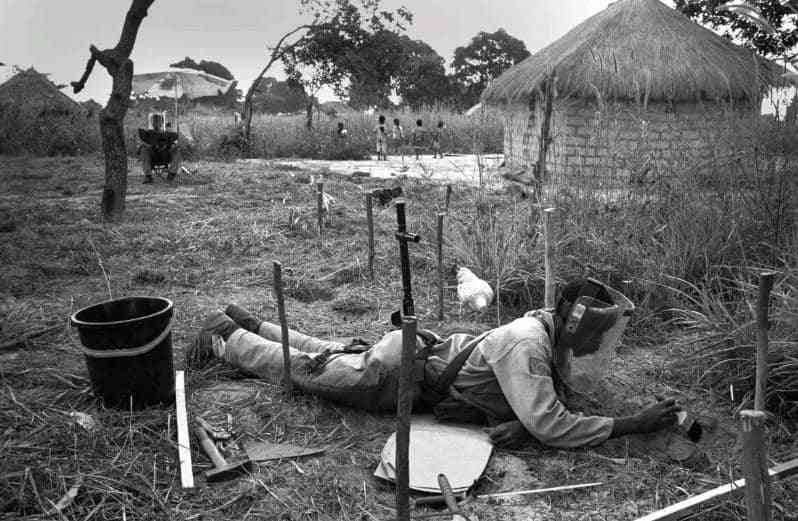
ANGOLA and Cambodia remain among the most heavily landmined countries in the world. Despite decades of international efforts, millions of square meters of contaminated land still exist, leaving both countries grappling with the lethal remnants of war. From the civil war in Angola to the Khmer Rouge regime in Cambodia, landmines continue to kill and maim civilians, with little progress in sight for complete demining.
Angola's struggle with landmines dates to its long wars first for independence from Portugal (1961–1974) and then through a brutal civil war (1975–2002). These conflicts left Angola as one of the most mined countries, with over 73 million square meters of land still considered hazardous. In addition to the land's contamination, more than 1,100 known and suspected minefields remain, according to recent estimates. By 2014, Angola registered over 88,000 individuals with disabilities resulting from mines and unexploded ordnance, although many believe the actual figure to be higher.
One of the biggest challenges in Angola has been a sharp reduction in donor funding. From 2005 to 2017, international financial support for demining operations in the country fell by more than 80%. The situation worsened in 2022, as many Western countries shifted their attention and resources to Ukraine amidst the ongoing conflict. This shift has slowed demining efforts and placed additional strain on Angola’s already limited national resources, especially given the volatile nature of its economy, heavily reliant on oil exports. All these human casualties in Angola and Cambodia are the result of uncontrolled arms proliferation, enabled by the international community’s lack of oversight. Yet despite the suffering of these countries' civilians, we see these mistakes being repeated today in Ukraine.
Angola is a signatory of the Ottawa Treaty, a landmark international agreement aiming to eliminate anti-personnel landmines. Under the treaty, Angola was required to clear all known mined areas by 2013, a deadline that has since been extended multiple times most recently to 2028. Despite these obligations, progress has been slow, exacerbated by insufficient funding and operational delays.
In August 2024, tragedy struck in Luanda, Angola's capital, when several children found a mine, mistaking it for a toy. The resulting explosion killed three and left another severely injured. This incident starkly highlighted the ongoing threat landmines pose, even in urban areas.
Cambodia, another country devastated by landmines, faces similar challenges. The landmines left over from the Cambodian Civil War (1970–1975) and the Khmer Rouge era (1975–1979) have taken a heavy toll on the population. Estimates suggest that between 4 million and 6 million mines remain buried across the country. Since 1979, over 65,000 Cambodians have been injured or killed by landmines, with over 9,000 amputations recorded. Cambodia has set an ambitious goal of clearing all remaining mines by 2025, but experts are sceptical of this deadline, given the scale of contamination and limited resources available.
Several international organizations have been involved in demining efforts in both Angola and Cambodia. Among the most prominent are HALO Trust (UK/USA), Norwegian People's Aid (NPA), Mines Advisory Group (MAG), and APOPO (Belgium). HALO Trust, one of the largest humanitarian mine clearance organizations in the world, has been active in both Angola and Cambodia for decades. NPA and MAG are also heavily involved in mine clearance operations in these countries, while APOPO is known for its innovative use of trained rats to detect mines. These organizations work alongside national bodies such as Angola's National Commission on Demining and Humanitarian Assistance (CNIDAH) and the National Demining Institute (INAD), though challenges related to funding and resources continue to hamper progress.
The failure to clear landmines not only endangers lives but also hinders economic growth and development in both Angola and Cambodia. Landmines make vast swaths of land unusable for agriculture or development, impacting livelihoods and stunting recovery efforts in post-conflict regions. Furthermore, the costs of healthcare for mine victims are a significant burden on both nations. Despite international attention, progress in mine clearance has been slow. The world’s focus on Ukraine and other conflict zones has diverted essential funds and resources away from countries like Angola and Cambodia, prolonging their suffering.
- Dos Santos failed to provide a moral example
- International Renewable Conference and Expo- Electric vehicle: A revolution beckons in Zim
- Unique dance building couples’ romance
- Dos Santos failed to provide a moral example
Keep Reading
The upcoming Fifth Review Conference of the Anti-Personnel Mine Ban Convention (APMBC), set to take place in Cambodia in November 2024, offers an opportunity for world leaders to reassess global mine clearance efforts. It is imperative that the international community prioritizes funding for demining in countries like Angola and Cambodia, where civilians continue to suffer from the legacies of wars that ended decades ago.
The tragic loss of life in Luanda this August should serve as a reminder of the urgent need to redouble efforts in demining. International organizations, donor countries, and local governments must collaborate more effectively to ensure that landmines are eradicated once and for all. Without sustained effort and investment, the deadly remnants of war will continue to claim lives for generations to come








